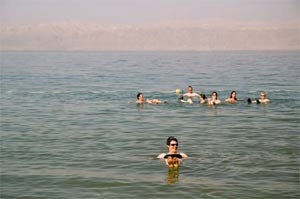Middle East uses Red Sea to save the Dead Sea
Jordan, Israeli and Palestinian officials met on 12-12 to discuss details of the project to prevent further decline of the Dead Sea. The parties agreed to deploy a plan to take water from the Red Sea to save the Dead Sea.
Floating people at the Dead Sea
The surface water level of the Dead Sea has lowered 0.91 m a year over the past 20 years due to evaporation and because rivers may have been deflected by Syria and Israel. The Dead Sea is home to the world's saltiest seawater.
 (Photo: Bioneural.net) The Dead Sea and the surrounding areas have long been the origin of human society history and it is also the connection between the three religions of one god, Jewish, Christian and Muslim.
(Photo: Bioneural.net) The Dead Sea and the surrounding areas have long been the origin of human society history and it is also the connection between the three religions of one god, Jewish, Christian and Muslim.
In 2005, the three concerned parties called on the World Bank (WB) to coordinate and finance a feasibility study. WB has accepted and called on donor countries. 4 countries Netherlands, France, Japan and the United States have pledged $ 15 million for research. The project will examine the environmental and social outcomes of leading water from the Red Sea to the Dead Sea, Jordan's Minister of Water and Irrigation, Mohammed Thafer al-Alem.
Geological experts warned that lower water levels would increase the likelihood of earthquakes. In addition, the Dead Sea will disappear within the next 50 years if this trend continues.
Israeli national infrastructure minister Binyamin Ben Eliezer said: "Research is a great model of cooperation, peace and conflict reduction."
The Red Sea-Dead Sea canal project could cost more than $ 1 billion. If the project is implemented, the 397-kilometer desert area between the two seas will benefit from cool water, and become the agricultural hub of the three countries. The calculated desalination project will bring drinking water to Amman. Israel and the Palestinians also benefit from this source.
- The cause of sand storms raging throughout the Middle East
- The Dead Sea once died once
- The Syrian war caused an unusual sandstorm in the Middle East
- The Dead Sea is likely to disappear completely
- Why is unusual snowfall in Vietnam, Egypt and the Middle East?
- Things to know about dangerous diseases Mers
- Mysterious wheel drawings in the Middle East
- Strange virus in the Middle East is about to cause a new SARS pandemic?
- Camels cause Middle East respiratory distress syndrome
- APEC, Africa and the Middle East strengthen bird flu alert
- The mysterious ancient stone circles in the Middle East
- Discovered the giant new spider in the Middle East
 Is the magnetic North Pole shift dangerous to humanity?
Is the magnetic North Pole shift dangerous to humanity? Washington legalizes the recycling of human bodies into fertilizer
Washington legalizes the recycling of human bodies into fertilizer Lightning stone - the mysterious guest
Lightning stone - the mysterious guest Stunned by the mysterious sunset, strange appearance
Stunned by the mysterious sunset, strange appearance